
Captain General of the Church
Encyclopedia
The Captain General of the Church was the de facto commander-in-chief
of the papal armed forces during the Middle Ages
. The post was usually conferred on an Italian noble with a professional military reputation or (later) a relative of the pope. The parallel office of Gonfalonier of the Church
was more a formal and ceremonial honor than the responsibility of a tactical military leader. Pope Innocent XII
removed both ranks and replaced them with the position of Flag-bearer of the Holy Roman Church (Italian
: Vessilifero di Santo Romana Chiesa), which later became hereditary in the Naro Patrizi.
It was traditional for the Captain General to carry a baton
of command, blessed by the pope.
Commander-in-Chief
A commander-in-chief is the commander of a nation's military forces or significant element of those forces. In the latter case, the force element may be defined as those forces within a particular region or those forces which are associated by function. As a practical term it refers to the military...
of the papal armed forces during the Middle Ages
Middle Ages
The Middle Ages is a periodization of European history from the 5th century to the 15th century. The Middle Ages follows the fall of the Western Roman Empire in 476 and precedes the Early Modern Era. It is the middle period of a three-period division of Western history: Classic, Medieval and Modern...
. The post was usually conferred on an Italian noble with a professional military reputation or (later) a relative of the pope. The parallel office of Gonfalonier of the Church
Gonfalonier of the Church
The Gonfalonier of the Church or Papal Gonfalonier was a military and political office of the Papal States. Originating from the use of the Papal banner during combat, the office later became largely ceremonial and political...
was more a formal and ceremonial honor than the responsibility of a tactical military leader. Pope Innocent XII
Pope Innocent XII
Pope Innocent XII , born Antonio Pignatelli, was Pope from 1691 to 1700.-Biography:He was born in Spinazzola to one of the most aristocratic families of the Kingdom of Naples, which included many Viceroys, and ministers to the crown, and was educated at the Jesuit college in Rome.In his twentieth...
removed both ranks and replaced them with the position of Flag-bearer of the Holy Roman Church (Italian
Italian language
Italian is a Romance language spoken mainly in Europe: Italy, Switzerland, San Marino, Vatican City, by minorities in Malta, Monaco, Croatia, Slovenia, France, Libya, Eritrea, and Somalia, and by immigrant communities in the Americas and Australia...
: Vessilifero di Santo Romana Chiesa), which later became hereditary in the Naro Patrizi.
It was traditional for the Captain General to carry a baton
Baton (symbol)
The ceremonial baton is a short, thick stick, carried by select high-ranking military officers as a uniform article. The baton is distinguished from the swagger stick in being thicker and less functional . Unlike a staff of office, a baton is not rested on the ground...
of command, blessed by the pope.
List of Captains General
| Captain General | Portrait | Appointing Pope | Notes |
|---|---|---|---|
| Charlemagne Charlemagne Charlemagne was King of the Franks from 768 and Emperor of the Romans from 800 to his death in 814. He expanded the Frankish kingdom into an empire that incorporated much of Western and Central Europe. During his reign, he conquered Italy and was crowned by Pope Leo III on 25 December 800... * |
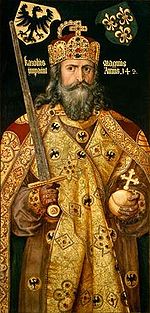 |
Leo III Pope Leo III Pope Saint Leo III was Pope from 795 to his death in 816. Protected by Charlemagne from his enemies in Rome, he subsequently strengthened Charlemagne's position by crowning him as Roman Emperor.... (798-816) |
"It is safest to conclude that the pope desired that the royal patrician should regard himself as captain-general of the church, and that he should in that capacity be entitled to the military services of its subjects, when called on by the church to interfere for the protection of her temporary rights."The Historians' History of the World. 1909. p. 662. |
| Guillaume Durand Guillaume Durand Guillaume Durand, or William Durand, , also known as Durandus, Duranti or Durantis, from the Italian form of Durandi filius, as he sometimes signed himself, was a French canonist and liturgical writer, and Bishop of Mende.-Life:He was born at Puimisson, near Béziers, of a noble family of Languedoc... |
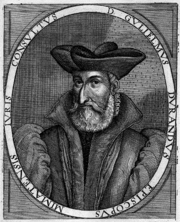 |
Martin IV Pope Martin IV Pope Martin IV, born Simon de Brion held the papacy from February 21, 1281 until his death.... (1281-1285) |
|
| James II of Aragon James II of Aragon James II , called the Just was the King of Sicily from 1285 to 1296 and King of Aragon and Valencia and Count of Barcelona from 1291 to 1327. In 1297 he was granted the Kingdom of Sardinia and Corsica... |
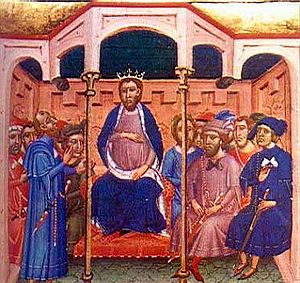 |
Boniface VIII Pope Boniface VIII Pope Boniface VIII , born Benedetto Gaetani, was Pope of the Catholic Church from 1294 to 1303. Today, Boniface VIII is probably best remembered for his feuds with Dante, who placed him in the Eighth circle of Hell in his Divina Commedia, among the Simonists.- Biography :Gaetani was born in 1235 in... (1294-1303) |
Gonfalonier Gonfalonier of the Church The Gonfalonier of the Church or Papal Gonfalonier was a military and political office of the Papal States. Originating from the use of the Papal banner during combat, the office later became largely ceremonial and political... , Admiral, and Captain General of the Church; compelled to wage war against his own brother (c.f. Sicilian Vespers Sicilian Vespers The Sicilian Vespers is the name given to the successful rebellion on the island of Sicily that broke out on the Easter of 1282 against the rule of the French/Angevin king Charles I, who had ruled the Kingdom of Sicily since 1266. Within six weeks three thousand French men and women were slain by... ) |
| Philip VI of France Philip VI of France Philip VI , known as the Fortunate and of Valois, was the King of France from 1328 to his death. He was also Count of Anjou, Maine, and Valois from 1325 to 1328... |
 |
Benedict XII Pope Benedict XII Pope Benedict XII , born Jacques Fournier, the third of the Avignon Popes, was Pope from 1334 to 1342.-Early life:... (1334-1342) |
Circa August 1336 |
| Juan Fernández de Heredia Juan Fernández de Heredia Juan Fernández de Heredia was the Grand Master of the Knights Hospitaller from 24 September 1377 to his death. His tenure was occupied by the "affair of Achaea." He was also a great patron of the translation and composition of historiographical works in the Aragonese language and a counsellor to... |
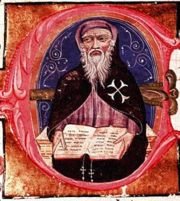 |
Innocent VI Pope Innocent VI Pope Innocent VI , born Étienne Aubert; his father was Adhemar Aubert seigneur de Montel-De-Gelas in Limousin province. His niece was Catherine Aubert, Dame de Boutheon, also the wife of Randon II baron de Joyeuse; she is La Fayette's ancestor... (1352-1362) |
|
| Daniele del Carretto | Gregory XI Pope Gregory XI Gregory XI was pope from 1370 until his death.-Biography:He was born Pierre Roger de Beaufort, in Maumont, in the modern commune of Rosiers-d'Égletons, Limousin around 1336. He succeeded Pope Urban V in 1370, and was pope until 1378... (1370-1378) |
||
| Carlo I Malatesta Carlo I Malatesta Carlo I Malatesta was an Italian condottiero during the Wars in Lombardy and lord of Rimini, Fano, Cesena and Pesaro... |
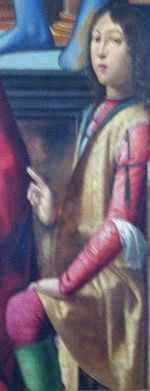 |
Boniface IX Pope Boniface IX Pope Boniface IX , born Piero Tomacelli, was the second Roman Pope of the Western Schism from November 2, 1389, until October 1, 1404... (1389-1404) |
"temporary vicar and captain-general of the church" |
| Braccio da Montone Braccio da Montone frame|Braccio da Montone.Braccio da Montone , born Andrea Fortebracci, and also known as Braccio Fortebraccio, was an Italian condottiero.-Biography:... |
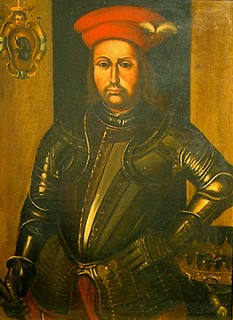 |
Gregory XII Pope Gregory XII Pope Gregory XII , born Angelo Correr or Corraro, Pope from 1406 to 1415, succeeded Pope Innocent VII on 30 November 1406.... (1406-1415) |
Appointed in 1414; "Used the army nominally belonging to the Pope to conquer Perugia Perugia Perugia is the capital city of the region of Umbria in central Italy, near the River Tiber, and the capital of the province of Perugia. The city is located about north of Rome. It covers a high hilltop and part of the valleys around the area.... for himself" |
| Ranuccio Farnese il Vecchio Ranuccio Farnese il Vecchio Ranuccio Farnese was an Italian nobleman, feudal lord and condottiero.Born in Ischia, he is considered the founder of the fortunes of the Farnese family. In 1416 Ranuccio succeeded his father as commander-in-chief of the Republic of Siena's troops, and defeated the Orsini of Pitigliano... |
Eugene IV Pope Eugene IV Pope Eugene IV , born Gabriele Condulmer, was pope from March 3, 1431, to his death.-Biography:He was born in Venice to a rich merchant family, a Correr on his mother's side. Condulmer entered the Order of Saint Augustine at the monastery of St. George in his native city... (1431-1447) |
Appointed 1435; grandfather of Pope Paul III Pope Paul III Pope Paul III , born Alessandro Farnese, was Pope of the Roman Catholic Church from 1534 to his death in 1549. He came to the papal throne in an era following the sack of Rome in 1527 and rife with uncertainties in the Catholic Church following the Protestant Reformation... |
|
| Niccolò Piccinino Niccolò Piccinino Niccolò Piccinino was an Italian condottiero.-Biography:He was born at Perugia, was the son of a butcher.He began his military career in the service of Braccio da Montone, who at that time was waging war against Perugia on his own account, and at the death of his chief, shortly followed by that of... |
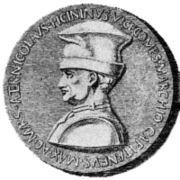 |
Appointed June 6, 1442; Condottiero; also the commander of the Duke of Milan's forces and thus "one of the first concrete indications" of the alliance between the pope and Milan Milan Milan is the second-largest city in Italy and the capital city of the region of Lombardy and of the province of Milan. The city proper has a population of about 1.3 million, while its urban area, roughly coinciding with its administrative province and the bordering Province of Monza and Brianza ,... |
|
| Jacques Cœur Jacques Cœur Jacques Cœur , was a French merchant, one of the founders of the trade between France and the Levant.- Origins :He was born at Bourges, the city where his father, Pierre Cœur, was a rich merchant... |
Nicholas V Pope Nicholas V Pope Nicholas V , born Tommaso Parentucelli, was Pope from March 6, 1447 to his death in 1455.-Biography:He was born at Sarzana, Liguria, where his father was a physician... (1447-1455) |
Died as Captain General | |
| Ludovico Trevisan | 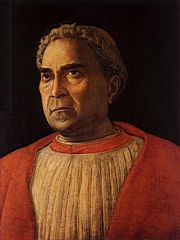 |
Callixtus III Pope Callixtus III Pope Callixtus III , né Alfons de Borja, was Pope from April 8, 1455 to his death in 1458.-Biography:... (1455-1458) |
Trevisan played an important role in organizing the naval campaign against the Ottomans in December 1455, both responsible for the construction of the papal navy and appointed "apostolic legate, governor general, captain and general condottiere" in charge of it. |
| Pedro Luis de Borja Pedro Luis de Borja Pedro Luis de Borja was younger brother of Rodrigo Borgia and nephew of Cardinal Alonso de Borja, who in 1455 became Pope Callixtus III. He was called Don Pedro Luis.... |
Also Prefect of Rome Praefectus urbi The praefectus urbanus or praefectus urbi, in English the urban prefect, was prefect of the city of Rome, and later also of Constantinople. The office originated under the Roman kings, continued during the Republic and Empire, and held high importance in late Antiquity... Not to be confused with Pedro Luis de Borja Lanzol de Romaní Pedro Luis de Borja Lanzol de Romaní Pedro Luis de Borja Lanzol de Romaní, O.S.Io.Hieros. was a Roman Catholic cardinal and cardinal-nephew and papal military leader. He received a wide variety of sinecures during the papacy of his great-uncle, Pope Alexander VI, but was exiled to Naples on the election of Borja rival Pope Julius II... |
||
| Antonio Piccolomini | Pius II Pope Pius II Pope Pius II, born Enea Silvio Piccolomini was Pope from August 19, 1458 until his death in 1464. Pius II was born at Corsignano in the Sienese territory of a noble but decayed family... (1458-1464) |
Son of the sister of Pius II; lay relative; salary of 2000 ducats a year and castellan of Castel Sant'Angelo Castel Sant'Angelo The Mausoleum of Hadrian, usually known as the Castel Sant'Angelo, is a towering cylindrical building in Parco Adriano, Rome, Italy. It was initially commissioned by the Roman Emperor Hadrian as a mausoleum for himself and his family... ; hereditary principate as Duke of Amalfi, conferred through King Ferrante, an office held by later papal relatives as well |
|
| Girolamo Riario Girolamo Riario Girolamo Riario was Lord of Imola and Forlì in the 15th century.- Biography :Born in Savona, Riario was the son of Paolo Riario and Bianca della Rovere... |
Sixtus IV Pope Sixtus IV Pope Sixtus IV , born Francesco della Rovere, was Pope from 1471 to 1484. His accomplishments as Pope included the establishment of the Sistine Chapel; the group of artists that he brought together introduced the Early Renaissance into Rome with the first masterpiece of the city's new artistic age,... (1471-1484) |
Pazzi conspirator Pazzi The Pazzi family were an ancient, noble Tuscan family who had given up their titles so that members could be elected to public office. Their main trade, during the 15th century was banking. They are linked to the "Pazzi conspiracy"—to assassinate Giuliano de' Medici and simultaneously attempt... ; brother of cardinal-nephew Cardinal-nephew A cardinal-nephew is a cardinal elevated by a Pope who is that cardinal's uncle, or, more generally, his relative. The practice of creating cardinal-nephews originated in the Middle Ages, and reached its apex during the 16th and 17th centuries. The word nepotism originally referred specifically to... Pietro Riario Pietro Riario Pietro Riario was an Italian cardinal and Papal diplomat.-Biography:Born in Savona, he was the son of Paolo Riario and Pope Sixtus IVs' sister, Bianca Della Rovere. Sixtus nominated him in 1471 bishop of Treviso and cardinal, and, in 1473, archbishop of Florence. He was entrusted with Sixtus'... ; title later removed |
|
| Franceschetto Cybo Franceschetto Cybo Franceschetto Cybo was an Italian nobleman, the illegitimate son of Pope Innocent VIII .... |
Innocent VIII Pope Innocent VIII Pope Innocent VIII , born Giovanni Battista Cybo , was Pope from 1484 until his death.-Early years:Giovanni Battista Cybo was born at Genoa of Greek extraction... (1484-1492) |
Illegitimate son of Innocent VIII | |
| Roberto Eustachio | Former condottiero for Milan; led the campaign against Alfonso of Calabria Alfonso II of Naples Alfonso II of Naples , also called Alfonso II d'Aragon, was King of Naples from 25 January 1494 to 22 February 1495 with the title King of Naples and Jerusalem... ; later returned to the service of the Republic of Venice Republic of Venice The Republic of Venice or Venetian Republic was a state originating from the city of Venice in Northeastern Italy. It existed for over a millennium, from the late 7th century until 1797. It was formally known as the Most Serene Republic of Venice and is often referred to as La Serenissima, in... |
||
| Niccolò di Pitigliano Niccolò di Pitigliano Niccolò di Pitigliano was an Italian condottiero best known as the Captain-General of the Venetians during the Most Serene Republic's war against the League of Cambrai... (Orsini) |
 |
Appointed June 27, 1489, in the midst of a conflict with Ferrante Ferdinand I of Naples Ferdinand I , also called Don Ferrante, was the King of Naples from 1458 to 1494. He was the natural son of Alfonso V of Aragon by Giraldona Carlino.-Biography:... |
|
| Giovanni Borgia Giovanni Borgia (1474) Giovanni Borgia, 2nd duke of Gandía was the son of Pope Alexander VI and the brother of Cesare Borgia, Gioffre Borgia, and Lucrezia Borgia. Giovanni, also known as Juan or Joan, was the second of the Pope's four children by Vanozza de' Catanei... |
 |
Alexander VI Pope Alexander VI Pope Alexander VI , born Roderic Llançol i Borja was Pope from 1492 until his death on 18 August 1503. He is one of the most controversial of the Renaissance popes, and his Italianized surname—Borgia—became a byword for the debased standards of the Papacy of that era, most notoriously the Banquet... (1492-1503) |
Son; also Duke of Gandia Duke of Gandia The hereditary Spanish title duke of Gandía was created in 1485 by Ferdinand II of Aragon from the original Italian title "duke of Candia" belonging to the Italian Stato di Mare or Italian Kingdoms of the Mediterranean Sea; originally granted around 1206 to a Genoan marquis member of the House of... and Gonfalonier Gonfalonier of the Church The Gonfalonier of the Church or Papal Gonfalonier was a military and political office of the Papal States. Originating from the use of the Papal banner during combat, the office later became largely ceremonial and political... ; assassinated, perhaps by his brother Cesare |
| Cesare Borgia Cesare Borgia Cesare Borgia , Duke of Valentinois, was an Italian condottiero, nobleman, politician, and cardinal. He was the son of Pope Alexander VI and his long-term mistress Vannozza dei Cattanei. He was the brother of Lucrezia Borgia; Giovanni Borgia , Duke of Gandia; and Gioffre Borgia , Prince of Squillace... |
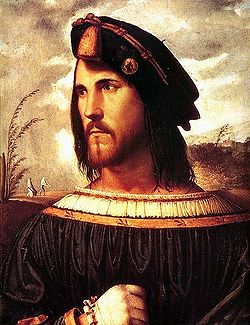 |
Son; former cardinal-nephew Cardinal-nephew A cardinal-nephew is a cardinal elevated by a Pope who is that cardinal's uncle, or, more generally, his relative. The practice of creating cardinal-nephews originated in the Middle Ages, and reached its apex during the 16th and 17th centuries. The word nepotism originally referred specifically to... , also Gonfalonier Gonfalonier of the Church The Gonfalonier of the Church or Papal Gonfalonier was a military and political office of the Papal States. Originating from the use of the Papal banner during combat, the office later became largely ceremonial and political... ; often accused of Giovanni's assassination, either directly or indirectly. Julius II, the "Warrior Pope", refused to confirm Cesare upon his election. |
|
| Francesco Maria I della Rovere Francesco Maria I della Rovere Francesco Maria I della Rovere was an Italian condottiero, who was Duke of Urbino from 1508 until 1538.- Biography :... |
 |
Julius II Pope Julius II Pope Julius II , nicknamed "The Fearsome Pope" and "The Warrior Pope" , born Giuliano della Rovere, was Pope from 1503 to 1513... (1503-1513) |
Son of Julius II's brother, Giovanni, and the adopted heir of Guidobaldo, Duke of Urbino; retained for one year after Julius II's death, paid 13,844 ducat Ducat The ducat is a gold coin that was used as a trade coin throughout Europe before World War I. Its weight is 3.4909 grams of .986 gold, which is 0.1107 troy ounce, actual gold weight... s plus a 30,000 ducat allowance for his company of 200 men-at-arms and 100 light cavalry |
| Giovanni Rucellai Giovanni Rucellai Giovanni Rucellai is the name of a father and grandson of the Rucellai family wool-dyers turned bankers.The former, Giovanni di Paolo, or Giovanni I, as the effective head of the Rucellai family commissioned the building of the Palazzo Rucellai, designed by Leon Battista Alberti and the father of... |
Leo X Pope Leo X Pope Leo X , born Giovanni di Lorenzo de' Medici, was the Pope from 1513 to his death in 1521. He was the last non-priest to be elected Pope. He is known for granting indulgences for those who donated to reconstruct St. Peter's Basilica and his challenging of Martin Luther's 95 Theses... (1513-1521) |
Cousin of Leo X | |
| Giuliano di Lorenzo de' Medici Giuliano di Lorenzo de' Medici Giuliano di Lorenzo de' Medici was an Italian nobleman, one of three sons of Lorenzo the Magnificent.-Biography:He was born in Florence, Italy. His brothers were Piero and Giovanni de' Medici.... |
 |
Giuliono's son Giulio Pope Clement VII Clement VII , born Giulio di Giuliano de' Medici, was a cardinal from 1513 to 1523 and was Pope from 1523 to 1534.-Early life:... (future Pope Clement VII) was papal legate to the army |
|
| Lorenzo II de' Medici, Duke of Urbino |  |
Appointed after the death of Giuliano in 1516; initially commanded the papal army in the War of Urbino War of Urbino The War of Urbino was a secondary episode of the Italian Wars.The conflict ensued after the end of the War of the League of Cambrai , when Francesco Maria I della Rovere decided to take advantage of the situation to recover the Duchy of Urbino, from which he had been ousted in the previous year.In... (1517) |
|
| Bernardo Dovizi Bernardo Dovizi Bernardo Dovizi or Bibbiena was an Italian cardinal and comedy-writer, known best as Cardinal Bibbiena, for the town Bibbiena, where he was born.-Biography:... |
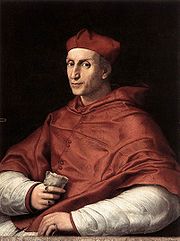 |
Appointed after the wounding of Lorenzo; commanded the papal army in the War of Urbino War of Urbino The War of Urbino was a secondary episode of the Italian Wars.The conflict ensued after the end of the War of the League of Cambrai , when Francesco Maria I della Rovere decided to take advantage of the situation to recover the Duchy of Urbino, from which he had been ousted in the previous year.In... (1517) |
|
| Federico II, Duke of Mantua |  |
Son of Isabella d'Este Isabella d'Este Isabella d'Este was Marchesa of Mantua and one of the leading women of the Italian Renaissance as a major cultural and political figure. She was a patron of the arts as well as a leader of fashion, whose innovative style of dressing was copied by women throughout Italy and at the French court... ; also Gonfalonier Gonfalonier of the Church The Gonfalonier of the Church or Papal Gonfalonier was a military and political office of the Papal States. Originating from the use of the Papal banner during combat, the office later became largely ceremonial and political... ; did not intervene in the Sack of Rome (1527) Sack of Rome (1527) The Sack of Rome on 6 May 1527 was a military event carried out by the mutinous troops of Charles V, Holy Roman Emperor in Rome, then part of the Papal States... |
|
| Adrian VI Pope Adrian VI Pope Adrian VI , born Adriaan Florenszoon Boeyens, served as Pope from 9 January 1522 until his death some 18 months later... (1522-1523) |
|||
| Francesco Maria I della Rovere Francesco Maria I della Rovere Francesco Maria I della Rovere was an Italian condottiero, who was Duke of Urbino from 1508 until 1538.- Biography :... |
Clement VII Pope Clement VII Clement VII , born Giulio di Giuliano de' Medici, was a cardinal from 1513 to 1523 and was Pope from 1523 to 1534.-Early life:... (1523-1535) |
Reappointed by Clement VII after his Dukedom had been stripped by Leo X and then reinstated by Adrian IV Pope Adrian IV Pope Adrian IV , born Nicholas Breakspear or Breakspeare, was Pope from 1154 to 1159.Adrian IV is the only Englishman who has occupied the papal chair... |
|
| Pier Luigi Farnese Pier Luigi Farnese, Duke of Parma Pier Luigi Farnese was the first Duke of Parma, Piacenza and Castro, from 1545 to 1547.Born in Rome, Pier Luigi was the illegitimate son of Cardinal Alessandro Farnese... |
Paul III Pope Paul III Pope Paul III , born Alessandro Farnese, was Pope of the Roman Catholic Church from 1534 to his death in 1549. He came to the papal throne in an era following the sack of Rome in 1527 and rife with uncertainties in the Catholic Church following the Protestant Reformation... (1534-1549) |
Appinted February 2, 1537l; son of Paul III and former Gonfaloniere (appointed January 1535); held both titles simultaneously | |
| Giambattista del Monte | Julius III Pope Julius III Pope Julius III , born Giovanni Maria Ciocchi del Monte, was Pope from 7 February 1550 to 1555.... (1550-1555) |
Nephew of Julius III | |
| Guidobaldo II della Rovere Guidobaldo II della Rovere Guidobaldo II della Rovere was an Italian condottiero, who was Duke of Urbino from 1538 until his death.- Biography :... |
 |
||
| Giovanni Carafa Giovanni Carafa, Duke of Paliano Giovanni Carafa , Duke of Paliano, was a papal nephew and minor Italian prince.The son of Giovanni Alfonso Carafa, Count of Montorio, and Caterina Cantelma, Giovanni came to prominence along with his brothers Carlo and Antonio when their uncle, Cardinal Giovanni Pietro Carafa, was elected Pope Paul... |
Paul IV Pope Paul IV Pope Paul IV, C.R. , né Giovanni Pietro Carafa, was Pope from 23 May 1555 until his death.-Early life:Giovanni Pietro Carafa was born in Capriglia Irpina, near Avellino, into a prominent noble family of Naples... (1555-1559) |
Appointed after the resignation of Guidobaldo; nephew of Paul IV; allegedly "affable and incompetent" | |
| Marcantonio Colonna Marcantonio Colonna Marcantonio II Colonna , Duke and Prince of Paliano, was an Italian general and admiral.-Biography:... |
Gregory XIII Pope Gregory XIII Pope Gregory XIII , born Ugo Boncompagni, was Pope from 1572 to 1585. He is best known for commissioning and being the namesake for the Gregorian calendar, which remains the internationally-accepted civil calendar to this date.-Youth:He was born the son of Cristoforo Boncompagni and wife Angela... (1572-1585) |
Lead the papal fleet during the Battle of Lepanto (1571) Battle of Lepanto (1571) The Battle of Lepanto took place on 7 October 1571 when a fleet of the Holy League, a coalition of Catholic maritime states, decisively defeated the main fleet of the Ottoman Empire in five hours of fighting on the northern edge of the Gulf of Patras, off western Greece... |
|
| Taddeo Barberini Taddeo Barberini Taddeo Barberini was an Italian nobleman of the House of Barberini who became Prince of Palestrina and Gonfalonier of the Church; commander of the Papal Army. He was a nephew of Pope Urban VIII and brother of Cardinals Francesco Barberini and Antonio Barberini... |
 |
Urban VIII Pope Urban VIII Pope Urban VIII , born Maffeo Barberini, was pope from 1623 to 1644. He was the last pope to expand the papal territory by force of arms, and was a prominent patron of the arts and reformer of Church missions... (1623-1644) |
Brother of cardinal-nephew Cardinal-nephew A cardinal-nephew is a cardinal elevated by a Pope who is that cardinal's uncle, or, more generally, his relative. The practice of creating cardinal-nephews originated in the Middle Ages, and reached its apex during the 16th and 17th centuries. The word nepotism originally referred specifically to... Antonio Barberini Antonio Barberini Antonio Barberini was an Italian Catholic cardinal, Archbishop of Reims, military leader, patron of the arts and a prominent member of the House of Barberini. As one of the cardinal-nephews of Pope Urban VIII and a supporter of France, he played a significant role at a number of the papal... |
| Antonio Ottoboni Antonio Ottoboni Antonio Ottoboni was father of Pietro Ottoboni .Prince Antonio Ottoboni, a general of the papal army, came to Naples in 1694.... |
 |
Alexander VIII Pope Alexander VIII Pope Alexander VIII , born Pietro Vito Ottoboni, was Pope from 1689 to 1691.-Early life:Pietro Ottoboni was born of a noble Venetian family, and was the son of Marco Ottoboni, chancellor of the Republic of Venice... (1689-1691) |
See also
- Captain GeneralCaptain GeneralCaptain general is a high military rank and a gubernatorial title.-History:This term Captain General started to appear in the 14th century, with the meaning of commander in chief of an army in the field, probably the first usage of the term General in military settings...
, for similarly named ranks - Gonfalonier of the ChurchGonfalonier of the ChurchThe Gonfalonier of the Church or Papal Gonfalonier was a military and political office of the Papal States. Originating from the use of the Papal banner during combat, the office later became largely ceremonial and political...
- CondottieriCondottierithumb|Depiction of [[Farinata degli Uberti]] by [[Andrea del Castagno]], showing a 15th century condottiero's typical attire.Condottieri were the mercenary soldier leaders of the professional, military free companies contracted by the Italian city-states and the Papacy, from the late Middle Ages...
- Papal StatesPapal StatesThe Papal State, State of the Church, or Pontifical States were among the major historical states of Italy from roughly the 6th century until the Italian peninsula was unified in 1861 by the Kingdom of Piedmont-Sardinia .The Papal States comprised territories under...

